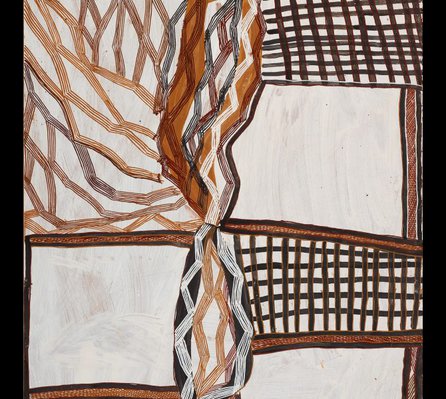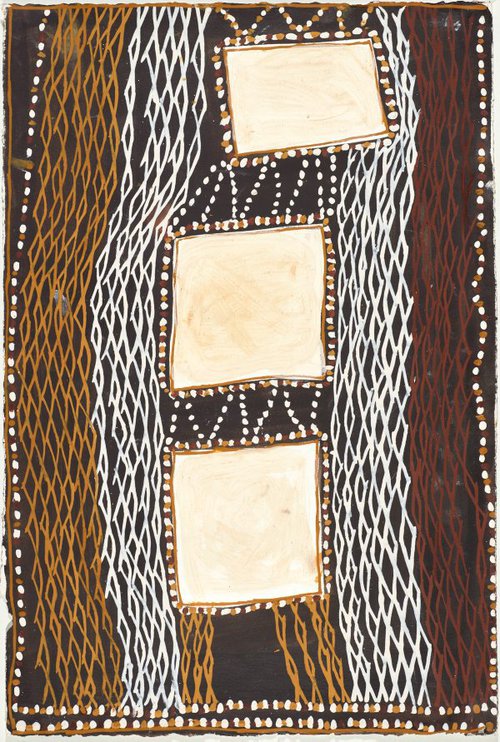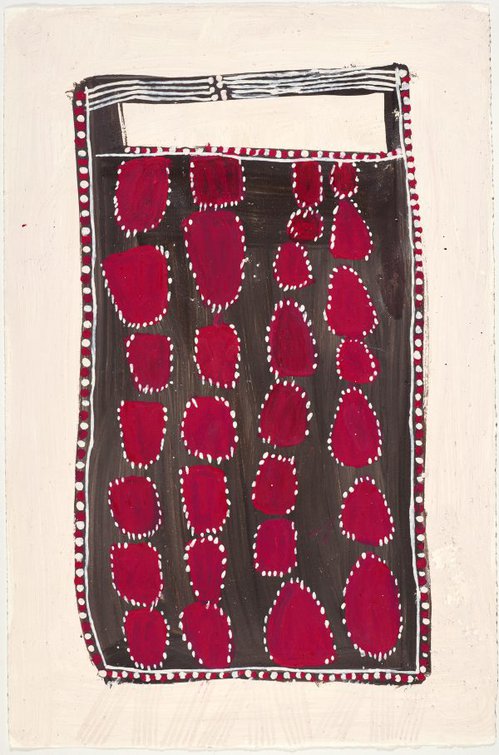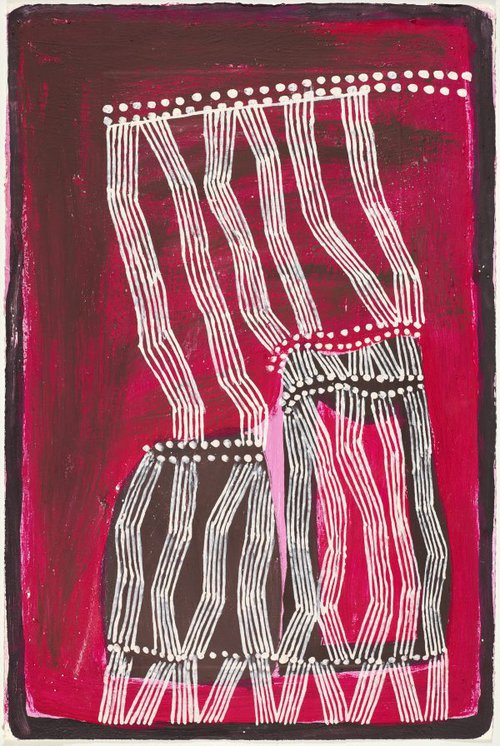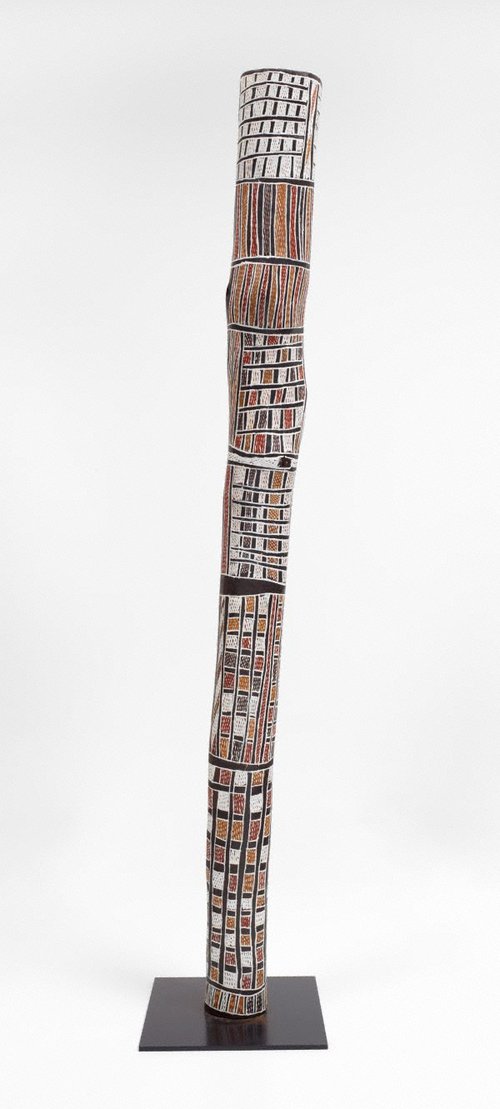Title
Baratjala
2014
Artist
-
Details
- Other Title
- Baratjula
- Place where the work was made
-
Yirrkala
→
North-east Arnhem Land
→
Northern Territory
→
Australia
- Cultural origin
- Madarrpa, Arnhem region
- Date
- 2014
- Media category
- Painting
- Materials used
- natural pigments on board
- Dimensions
- 242.0 x 121.0 cm
- Signature & date
Not signed. Not dated.
- Credit
- Mollie Gowing Acquisition fund for Contemporary Aboriginal art 2016
- Location
- Not on display
- Accession number
- 301.2016
- Copyright
- © Noŋgirrŋa Marawili courtesy Buku-Larrŋgay Mulka Art Centre
- Artist information
-
N Marawili
Works in the collection
- Share
-
-
About
The Art Centre documentation for this works states:
The style of the works with a predominantly diamond patterning represents a shift from the Djapu works of her first show at Alcaston and into Madarrpa clan works from her second show in 2013.
The grid pattern is Djapu and the zigzag is Madarrpa.
It is unusual to see Yirritja and Dhuwa moiety patterns together in one piece. She is using these designs to model a landscape. The white panels are saltpans. The grid is referring to freshwater and the zigzag brackish and salt.
But it is not intended to be, nor is it strictly, a rendition of miny’tji (sacred clan design). Her father was a pre-contact warrior and leader who did not survive to the era when daughters were encouraged to paint. Having grown up under a strict regime where painting without authority could be a capital offence these works represent the culmination of her journey to a personal voice.
For three decades she painted as an assistant to her award winning Dhuwa moiety husband Djutjadjutja Munuŋgurr of the Djapu clan until his death.
She continued to paint under authorisation until this body of work when she began to venture into works inspired by her own Yirritja moiety themes of fire imbued saltwater.
The cross hatching grid pattern is the sacred design for the freshwaters of the Djapu clan at their homeland Wandawuy now an outstation about 150 kilometres south of Yirrkala and inland form Blue Mud Bay.
This Djapu clan outstation (and spiritual residence for ancestral beings Mäna the shark and Bol’ŋu the thunderman) is surrounded by permanent freshwater. Rains inspired by the actions of Bol’ŋu feed the rivers and fill the billabongs. Catfish and mussels, freshwater crayfish and others feed the Yolŋu and wild life. The water are home for the shark mäna. The grid refers to the landscape of Wandawuy – a network of billabongs surrounded by ridges and high banks. Its structure also having reference at one level to woven fish traps.
Ancestral hunters set a trap here to snare the shark but to no avail. These Yolŋu people are called Bärŋbarŋ and Monula who came to cut the trees named Guluwu, Gathurrmakarr, Nyenyi, Rulwirrika and Gananyarra – all Dhuwa trees.
They used straight young trees. And cut them with their axes called Gaymalarri, Bitjutju. Areas of the river are staked by the Yolŋu and branches interwoven through them. Then the water is polluted by a particular pulped bark that anaesthetises the Ganŋal that hobble to the surface. With nets constructed similarly to the beak of the Galumay the pelican, the Yolŋu wade through the waters scooping up the fish. It has been fished since ancestral times. Ganŋal the catfish, totem for the Djapu is ceremonially sung as is Galumay the pelican. Both these species frequent the waters of Wandawuy.
Mäna the ancestral shark in its epic travels comes through this way. These ancestors try to trap mana in the freshwater by means of these traps in the waterways. They fail. The powers and physical strength of the shark overcome the efforts of mere mortals. Mäna’s ire and thrashing tail smash the trap and muddy the water.
They witness however the strength of mana and sing his actions, thrashing of his tail for one, the muddying or contamination of the water. The grid lines having reference to the trap. The cross hatched squares referring to different states of the freshwater – the source of Djapu soul.
At ceremony appropriate participants for mortuary rites enter the shelter (woven together like the unsuccessful trap) where the deceased has been lying in state. Sacred spears tipped with stingray barbs, maninfestations of Mana’s teeth, stand up alongside the shelter. The sacred song cycles of Mana in the water at Wandawuy are intoned with music from the Yidaki (didjeridu) and bilma (clap sticks). At the prescribed time at the conclusion of the ceremony the dancers crash through the deceased’s shelter imitating the actions of Mana at the trap. This action has reference to the release of the deceased’s soul, back to the sacred waters of Wandawuy to be reunited with its ancestors awaiting rebirth.
Wandawuy literally means place of the shark’s head, where in the larger context of the song cycles of Mana’s journey his head came to rest after being butchered and distributed through the land.
The strings of diamonds resemble the classic miny’tji of the saltwater estate of Yathijkpa. Here, Baru the ancestral crocodile, carrying and being burnt by the ancestral fire, crossed the beach from Garraŋali (crocodile’s nest) and entered the saltwater. Later from the same beach ancestral hunters on seeing dugong took their hunting harpoon and canoe out to the sea of Yathikpa in pursuit. The hunters were ured too close to a forbidden and dangerous rock by the dugong shelter. The dugong here feed on the Gamata, a sea grass that is a manifestation of the flames on the sea bed. Wavy ribbons of seagrass sway in the sunlit water. Fire at this sacred site boiled the water capsizing the canoe. This is sometimes called an ancestral tide and it is speculated that this is the oral tradition on an ancient tsunami.
From here to the horizon where the waters of other Yirritja clans, the Dhalwaŋu, Maŋgalili and Munyuku merge and mingle. The hunter’s harpoon floats incessantly between the various coastal estates of these clans. It is also here that the feminine thunderclouds take up life giving water to rain back over the hinterlands, thence to flow through the river systems and met the saltwater tidal surge. The transformation of saltwater into fresh and back into salt mirrors the soul as it changes its outward form from corporeal to ethereal and so on.
These diamond based works are paintings of fire and simultaneously of water. It is abstract and unprecedented but suggests an elemental raw rendition of Madarrpa clan sacred design for the ocean at Yathikpa which is melting and crashing tot eh horizon. If pressed Noŋgirrŋa will deny this and refer to a different Madarrpa estate with no recorded sacred design of its own, Baratjula.
Baratjula is a Madarrpa clan estate adjacent to Cape Shield where the artist camped with her father and his many wives as a young girl. She lived nomadically as part of a clan group with a flotilla of canoes between Groot Eylandt and the mainland. Her father’s name was Mundukul (Lightning snake) and this is also the name of the serpent (also known as Water python, Burrut’tji or Liasis fuscus) which lives deep beneath the sea here.
Some of the designs show the rock set in deep water between the electric ‘curse’ that the snake spits into the sky in the form of lightning, and the spray of the sea trying to shift the rock foundation of the Madarrpa. Yurr’yunna is the word used to describe the rough waves overtopping the rock and the spray flying into the sky.
This journey from the sacred to the destructive shifts even further where she sues her mark making to portray more anonymous natural features of her landscape such as drying billabongs in the floodplains of cracking mud. Her identity cannot be separated from her art and so although she disavows any sacred intent the echo of miny’tji persists. -
Places
Where the work was made
Yirrkala
-
Exhibition history
Shown in 1 exhibition
Noŋgirrŋa Marawili: from my heart and mind, Art Gallery of New South Wales, Sydney, 03 Nov 2018–24 Feb 2019

